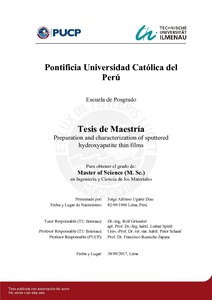| dc.contributor.advisor | Grieseler, Rolf | |
| dc.contributor.advisor | Schaaf, Peter | |
| dc.contributor.advisor | Rumiche Zapata, Francisco Aurelio | |
| dc.contributor.author | Ugarte Díaz, Jorge Alfonso | es_ES |
| dc.date.accessioned | 2018-01-19T21:30:45Z | es_ES |
| dc.date.available | 2018-01-19T21:30:45Z | es_ES |
| dc.date.created | 2017 | es_ES |
| dc.date.issued | 2018-01-19 | es_ES |
| dc.identifier.uri | http://hdl.handle.net/20.500.12404/9901 | |
| dc.description.abstract | In this work, hydroxyapatite (HAp) thin films were fabricated using two different
sputtering techniques: Radio frequency magnetron sputtering and ion beam sputtering. In
the first case, the films were grown on Ti-6Al-4V substrates using a high-purity
commercial HAp target, obtaining a thickness ~200 nm. For the second method, the film
were grown on pure titanium substrates using a self-produced HAp target. This target was
fabricated with powders (Ca/P = 1.628, sintered and crushed). Here, the thickness of the
fabricated film was ~300 nm. The sintering tests for the target fabrication were carried
out using two different heating regimens at a maximum temperature of 1200 °C (holding
time of 2h and 4h) using various additives. As additives, water (H2O), polyvinyl alcohol
(PVA) and polyethylene glycol (PEG) were used to improve the mechanical strength of
the green discs. The as-deposited films were amorphous in both cases. Therefore, the
films were annealed to increase the crystallinity. Annealing was performed in air for 2h
at temperatures: 400, 600 and 800 °C for RF-magnetron sputter samples; 600 and 800 °C
for ion beam sputter samples. The result of the films shows in both cases that the
crystallinity of HAp was improved only for the annealed samples fabricated with ion
beam sputtering at 800 °C. In both cases energy dispersive X-ray spectroscopy
measurements show a decrease in Ca/P ratio with increasing the temperature. Hardness
results revealed an increase in this with the increase in temperature possibly due to the
formation of titanium oxide. The roughness for the fabricated films with the RFmagnetron
sputtering increases till an annealing temperature of 600 °C and then decreases
till 800 °C, while the roughness for the fabricated films with ion beam sputtering is higher
in the as-deposited samples and then this is reduced by increasing the annealing
temperature. | es_ES |
| dc.description.uri | Tesis | es_ES |
| dc.language.iso | eng | es_ES |
| dc.publisher | Pontificia Universidad Católica del Perú | es_ES |
| dc.rights | info:eu-repo/semantics/openAccess | es_ES |
| dc.rights.uri | http://creativecommons.org/licenses/by-nc-nd/2.5/pe/ | * |
| dc.subject | Hidrocarburos policíclicos aromáticos--Propiedades mecánicas | es_ES |
| dc.subject | Películas delgadas | es_ES |
| dc.title | Preparation and characterization of sputtered hydroxyapatite thin films | es_ES |
| dc.type | info:eu-repo/semantics/masterThesis | es_ES |
| thesis.degree.name | Maestro en Ingeniería y Ciencia de los Materiales | es_ES |
| thesis.degree.level | Maestría | es_ES |
| thesis.degree.grantor | Pontificia Universidad Católica del Perú. Escuela de Posgrado | es_ES |
| thesis.degree.discipline | Ingeniería y Ciencia de los Materiales | es_ES |
| renati.advisor.cext | 001660902 | |
| renati.discipline | 713017 | es_ES |
| renati.level | https://purl.org/pe-repo/renati/level#maestro | es_ES |
| renati.type | http://purl.org/pe-repo/renati/type#tesis | es_ES |
| dc.publisher.country | PE | es_ES |
| dc.subject.ocde | https://purl.org/pe-repo/ocde/ford#2.05.01 | es_ES |






